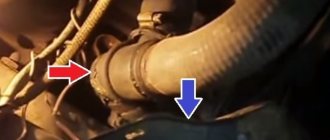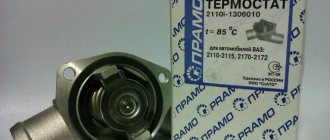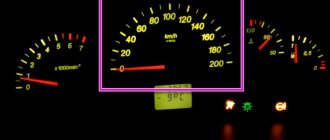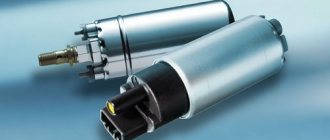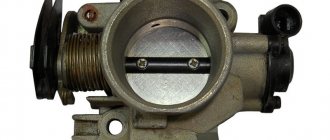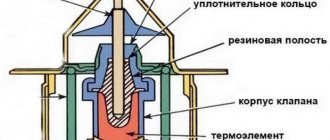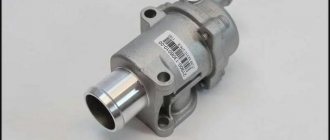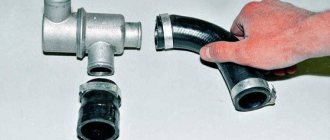Cars are improved from year to year. But despite the increase in engine power and volume, the liquid cooling system remains the same due to its high efficiency. One of the elements of this system is the thermostat. Its design is simple, but subject to certain malfunctions. Without proper control, this mechanism may fail. The article reveals the topic of why the thermostat is jammed, the main reasons for this phenomenon, signs of a malfunction of the thermostat, and important nuances of operation.
Device
Modern thermostats come in several types. The design depends on the volume of coolant in the system and the total pressure created by the water pump. 3 main designs:
- The simplest regulator with a non-separable brass body. It has only 3 pipes, as it is intended for small engines. Often installed on classic VAZ cars.
- A more advanced thermostat with a collapsible housing. Has more than 3 bends for connecting pipes.
- Similar to the previously described, but two-valve thermostat. Has 2 working locking mechanisms. It works on the principle of a single-valve regulator, but each valve closes a separate circulation circle.
Regardless of the model, the standard mechanism of this part consists of:
- Cylindrical, less often square, body made of brass, copper or aluminum.
- The body is equipped with tubular bends for attaching main rubber pipes.
- The main shutter valve, it is this that regulates the width of antifreeze circulation.
- The spring creates the necessary pressure on the valve when it is closed and returns it to the seat after opening.
- A special thermocouple consisting of a tube with a certain amount of wax inside.
- The rod contains all the components of the thermostat.
There are electronic thermostats that are similar in design, but are supplemented by a heating element and a power supply connector.
Features of testing on VAZ series cars
VAZ cars continue to be a truly “people's” vehicle. Let's look at how to check the thermostat on a car of this brand.
To begin with, we note that on all models of the Volzhsky Automobile Plant (VAZ 2107, 2114, 2109, 2110, 2114 and others), the principle of checking the thermostat is identical. The only thing that can change is the opening and closing temperature. But this information can be found in the instructions for your car.
As in previous cases, verification is carried out using two methods.
Principle of operation
The basic principle of operation of the thermostat is to alternately turn on the small and large cooling circles. This happens as follows:
- When the car is idle with the engine not running, the antifreeze temperature is approximately similar to the air temperature. In this case, the thermostat shutter valve is closed.
- After the engine has been started, the pump creates pressure for circulation, and due to the closed valve, the antifreeze circulates only in the engine/heater system. The radiator at this stage does not participate in cooling. The small volume of liquid and the closed cycle promotes rapid heating.
- As soon as the temperature of the cooling antifreeze crosses the threshold of 85 degrees, the thermostat opens, allowing the antifreeze to circulate in a large circle or throughout the entire system. This is necessary to balance temperature, pressure and maintain these values at a certain level.
This system was not invented by chance. It allows you to reduce the time it takes to warm up the engine and interior in winter, as well as maintain the operating temperature of the power unit at the temperature it requires.
Purpose and design features of the thermostat
The thermostat is designed to block the circulation of fluid through the cooling system until the car engine is completely warmed up in order to speed up this process and further maintain the required operating temperature.
Thermostat operating principle
is based on the melting of artificial wax placed in a small cylinder in the direction of the motor. Wax melts at a temperature of at least 80 degrees. At the same time, it expands, increasing in volume, due to which it squeezes the locking pin out of the cylinder, unlocking the thermostat valve and restoring circulation.
In general, a thermostat consists of:
- inlet pipe connected to the engine cooling system;
- bypass valve, which, if necessary, shuts off the small cooling circle;
- an outlet pipe connected to the coolant pump;
- spring holding the bypass valve;
- wax ball;
- inlet pipe connected to the radiator;
- springs holding the main valve;
- the main valve itself, designed to shut off the main circulation;
- piston;
- housings.
Before the engine warms up, the circulation of the coolant does not stop completely - it is carried out in a so-called small circle, where the coolant flows from the pump only through the cooling jacket and the heater radiator, so that the system does not stagnate. When the main circulation valve opens, the small circle is automatically closed.
That is, the entire thermostat device is actually just a cylinder, a return pin, wax and a number of minor parts. This simple thermostat circuit is effective and reliable, so it remains the same in most newer cars.
In different car models, thermostats are set to different opening temperatures, which are most often indicated on the device body. In addition, different cars can be installed with or without housing thermostats. Their main difference is the installation itself, either in the engine block, or in a separate housing, which is a complex two-level circuit.
Symptoms of malfunction
Often, due to improper care or operating errors, the thermostat fails. Symptoms of the malfunction are as follows:
- The engine takes a long time to warm up and does not reach operating temperature. In winter there is no heating at all. In this case, the engine loses some power and dynamism, and excessive fuel consumption occurs.
- The motor heats up very quickly and often overheats despite the fact that the fan and pump are working properly.
- Warming up occurs “intermittently”. When the power unit is first started, overheating occurs, but during further operation of the vehicle the problem does not appear. In this case, overheating can occur quite suddenly, especially at idle.
- The antifreeze level in the cooling system drops. This can be noticed when the machine is idle for a long time. Puddles form under the car, and air gets into the cooling system.
Any experienced car enthusiast knows the approximate time it takes to warm up the engine of a personal car. A cooling problem can be identified by increasing or decreasing the warm-up time. The main thing is to pay attention to signs of malfunction of the temperature control mechanism.
How it works?
Any engine uses two circuits:
Both contain coolant. However, after the engine starts, it heats up only in a “small” circle. This way the motor will quickly reach its operating temperature, which, as is known, is 80-90 degrees Celsius. The small circle is the heat exchanger of the stove and the engine itself. The second circuit includes a radiator with pipes, which has a large cooling area. This radiator is located in front of the engine. Additionally, air intake is provided by a special impeller. This could be a viscous coupling or an electric fan. But the operation of these elements no longer depends on the thermostat (the temperature sensor or the crankshaft drive belt is used here).
As you can see, the device has a simple operating principle. However, this mechanism sometimes fails. Signs of a malfunctioning thermostat installed on a Renault Logan are always accompanied by overheating. But first things first. So, below we will look at the main symptoms and signs of a thermostat malfunction.
Logan 1.6 has a copper thermostat. Its service life is quite long (10 years or more). But if it malfunctions, do not hesitate to replace it.
Possible faults
There are not many common causes of malfunction. These include:
- The thermostat is stuck in the closed position of the valve cup. This leads to overheating of the antifreeze.
- The thermostat is stuck in the valve cup open position. Warming up of the engine slows down significantly.
- The regulator is stuck in an intermediate position, that is, its shutter mechanism is not fully open. Poor heating occurs while driving and overheating occurs when the power unit is idling.
- The thermostat opens ahead of schedule. Leads to slower heating.
- For models with electronically controlled opening, the valve does not open at all. This causes the antifreeze to boil.
Each malfunction has a number of reasons. Each will be described in detail below.
Determining the functionality of the thermostat
In order to determine whether a given part works, you don’t even need to know where the thermostat is located. It is enough to simply warm up the engine, but do not bring its temperature to the red line. Then turn off the engine and open the hood, look for the upper and lower radiator hoses there. Simply touching them is enough. If one hose turns out to be hot, while the other remains cold, most likely the thermostat valve did not open when the engine was running, which means it is not operational and needs urgent replacement. The thermostat circuit is quite simple, the device is cheap, so there is no point in trying to repair it - changing it is much easier.
Closed position
This malfunction occurs most often. The reasons for such a problem may lie in the nuances of operating the machine. The thermostat does not open if:
- Too much scale, dirt, and oxidation have accumulated in its mechanism. The reason may be the use of ordinary tap water instead of antifreeze. Many people dilute antifreeze with distilled water, which also leads to scale formation in the system.
- Inappropriate antifreeze has been selected for the cooling system. Coolants are divided according to the degree and temperature of heating. If the thermostat response threshold is many times lower than the boiling point of the antifreeze, the opening time of the regulator will increase, which will lead to overheating.
- The return spring breaks or loses tension. The cause may be the device itself if it is not manufactured to the required standards. Often new regulators from unscrupulous manufacturers suffer from this problem. The spring may wear out from using water for cooling. Water oxidizes and reduces the life of the metal.
- The thermostat does not open due to a broken valve cup mounting. The reasons are similar to a broken spring.
- Failure of the thermoelement. This part becomes unusable due to breakdown or deformation of the tube in which the wax is enclosed. This element is very sensitive, since its work is based on the pressure created during expansion from heating.
- Electronic thermostats suffer from the problem of complete jamming due to a faulty thermistor, oxidation of the power connector contacts, or an open circuit. Often the cause may be a temperature sensor that is unable to determine the current system temperature.
All these features must be taken into account in the process of selection and further operation of this unit.
Checking functionality in 2 ways
Signs of a malfunction are the temperature arrow, which drops sharply when the engine speed increases and rises when the car is stopped. In addition, if the engine boils and the lower pipe remains cold, this indicates that the thermostat is stuck closed.
Without taking off
You can control the work using the temperature sensor, heating of the pipes and the time spent on it.
To perform the check you should:
- Start the engine and let it run for two minutes.
- Then check the hose going from the thermostat to the radiator. Normally, this area should be cold.
- On the other hand, if after some time it still does not heat up, then the valve is stuck.
- If the arrow of the coolant temperature sensor is in the red zone, and in cold weather the car takes a very long time to warm up, then this is direct evidence of a thermostat malfunction.
If such signs appear, you should seek professional help from specialists. Timely elimination of problems is a guarantee of high-quality operation of the cooling system.
By heating
When the thermostat is closed, the engine overheats because the coolant flows in a smaller circle. In this case, the heat remains inside the power unit. Otherwise, the engine may not have enough heat.
This requires dismantling the device. Before doing this, drain all remaining coolant from it. The next step is to clean the valve hole from scale.
To check the thermostat you need to do the following:
- heat a pan of water on the stove and place the device there;
- Using a thermometer with a scale of 100 degrees Celsius, monitor the temperature at which the valve opens, as well as the diameter of the opening hole.
When carrying out the described test, you need to focus on the temperature indicated on the thermostat body.
Another way to check is to measure the distances between the points of the device in a heated and cooled state using a caliper. Typically, the difference in readings should not exceed 7 mm.
It is recommended to check the valve for full opening on a warm thermostat. If a malfunction is detected, it is better to purchase a new part.
Open position
If the thermostat does not warm up the power unit in a timely manner, it means it is stuck in the open position. Possible reasons are as follows:
- Dirt or foreign objects getting into the shutter mechanism. These could be large pieces of scale, parts of sealant or gaskets.
- Spring failure due to metal rotting.
- The valve cup fastening is distorted or broken. Also occurs due to the use of water.
All these malfunctions often occur when the rules for operating the cooling system are not followed.
Half open position
This problem can arise due to foreign parts of gaskets and sealant getting under the locking cup. The cause may also be depressurization of the system and air leaks from the outside. Air pockets increase the pressure in the system. During a visual inspection, it is necessary to find and eliminate all antifreeze leaks at the joints of the pipes.
If the valve is not fully open, you should pay attention to an additional fan if the car is equipped with one. In such systems, cooling is divided into periods during which the 2nd fan is turned on. If it fails, the valve will open halfway, since the antifreeze temperature is at an intermediate value.
Important
It is extremely important to diagnose and repair thermostat malfunctions in a timely manner. You cannot operate a vehicle with a damaged circulation control element. Insufficient heating of the power unit will affect power, dynamism, and increased fuel consumption. Excessive heating and frequent overheating with boiling of antifreeze can lead to problems with the piston group and depressurization of the cylinder head. Such repairs are very complex and expensive. On modern cars, any problems with the cooling system are transmitted to the engine control unit. The ECU will react to problems and make adjustments to the operation of other systems, which will affect the overall performance of the machine.
